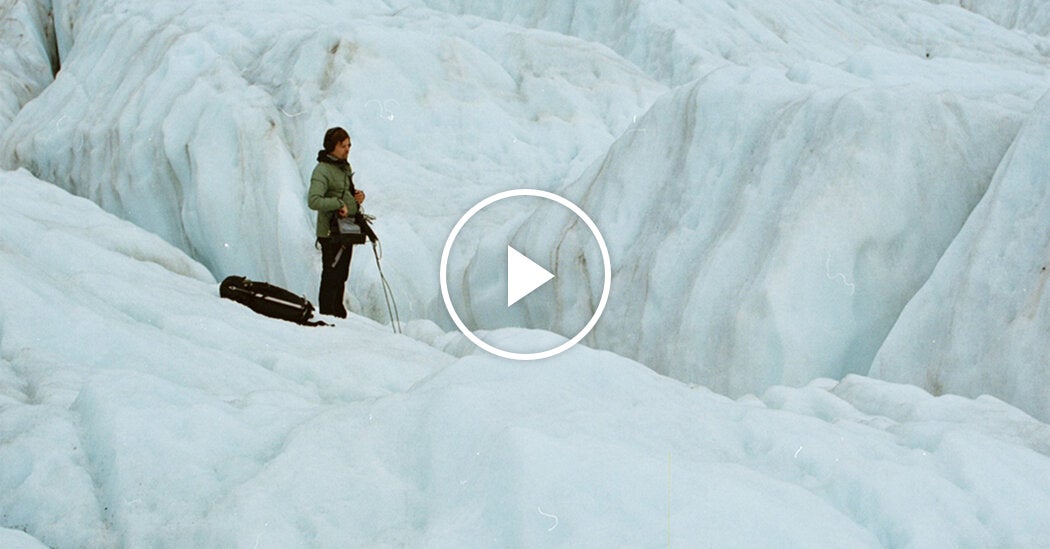The stark beauty of a glacier often masks a profound fragility. But what if these icy giants could speak? What stories would they tell? A recent Op-Doc short film, “Crying Glacier,” attempts to answer this question by capturing the sounds emanating from within a melting glacier, offering a visceral experience that transcends mere scientific data. The project, spearheaded by artist Ludwig Berger, seeks to document a disappearing environment, translating the glacier’s internal groans and pops into a lament for a world undergoing drastic change.
Berger’s work isn’t just about recording sounds; it’s about forging a personal connection with these colossal ice formations. As he explains in the film’s transcript:
When you look at this gigantic mass of ice, it’s hard to get a personal relationship to it. So we wanted to document this landscape to give us an idea of what it sounds like inside a glacier. There is also the sadness because you know that all these sounds are disappearing right now.
The sounds themselves are haunting. Tiny “plop” sounds, the release of ancient air bubbles trapped for centuries, maybe even millennia. Each plop, Berger notes, is gone forever, a tiny eulogy for a frozen past. It is a very hard experiece to process.
The film raises fundamental questions about our relationship with the environment. Are we truly listening to the planet’s distress signals? Are we considering the voices—both literal and metaphorical—of mountains, rivers, and glaciers in our discussions about climate change?
An Unexpected Anomaly emerged during the filming: the glacier seemed to “cry” more intensely during periods of warmer temperatures. The Immediate Reaction was to adjust recording equipment, initially thinking it was malfunctioning. The Lingering Question, however, became: what if the increased sound was a genuine expression of the glacier’s distress, a desperate plea for help?
The project isn’t without its critics. Some argue that anthropomorphizing glaciers is a dangerous path, blurring the lines between scientific understanding and emotional sentimentality. However, proponents argue that this approach is precisely what’s needed to awaken a sense of empathy and inspire action.
Here’s a summary of key viewpoints regarding the “Crying Glacier” project:
- Ludwig Berger: Sees the glacier’s sounds as a form of language, telling stories of the past and warning of the future.
- Critics: Caution against anthropomorphizing the environment, emphasizing the need for scientific rigor.
- Supporters: Believe the project can foster empathy and inspire action on climate change.
- Local Residents: Observe firsthand the glacier’s retreat and the impact on their livelihoods.
I spoke with a local resident, Elina Hansen, who lives near the glacier featured in the film. Her family has lived in the valley for generations, witnessing the glacier’s slow but steady decline. She described a profound sense of loss, not just of a natural wonder, but of a part of her heritage.
“We didn’t realize it until later,” she said, “how much the glacier meant to us. It was always just there, a constant presence. Now, it’s shrinking, and it feels like we’re losing something essential.”
Hansen added that she’d seen an increased uptick of people taking photographs. She said some days it almost felt like a party, which was odd given the subject matter.
The film doesn’t shy away from the harsh realities of climate change. It presents a stark vision of a future where glaciers may no longer exist, a future where the “last cry” of these icy giants becomes a chilling prophecy fulfilled. The project urges us to consider the glaciers not just as resources, but as entities with their own stories to tell, voices that deserve to be heard before they are forever silenced. One only wishes we could go back and change things.
The impact of “Crying Glacier” extends beyond the art world. The film has sparked conversations on social media, with viewers sharing their reactions and calling for greater awareness of climate change. On X.com, the hashtag #CryingGlacier has become a hub for discussions about environmental conservation and the importance of listening to the planet’s signals. Many users are demanding action for the planet. Other users posted images from Instragram of thier own travels to see glaciers, and expressed sadness about their rapid retreat. On Facebook many users linked the film to political debates, however most comments remained respectful and well-meaning.
The film’s central message resonates deeply: that the glaciers have become, really, the symbol of climate change. This raises pressing questions for all of us. For example, what are we willing to do to protect these vulnerable ecosystems? Are we prepared to change our consumption patterns, support sustainable policies, and demand greater accountability from our leaders?
Ultimately, “Crying Glacier” is a call to action, a reminder that the fate of these icy giants is intertwined with our own. Their cries are not just sounds of melting ice; they are echoes of our own fears and uncertainties about the future of our planet. The film, and Berger’s overall project, could drastically change our way of perceiving the world and shaping our actions. If everthing goes wrong, the glaciers are not there anymore in 100 years. And we can only imagine what this valley here will sound like when it’s not there anymore. So it’s almost like the last cry of the glacier in this valley.



